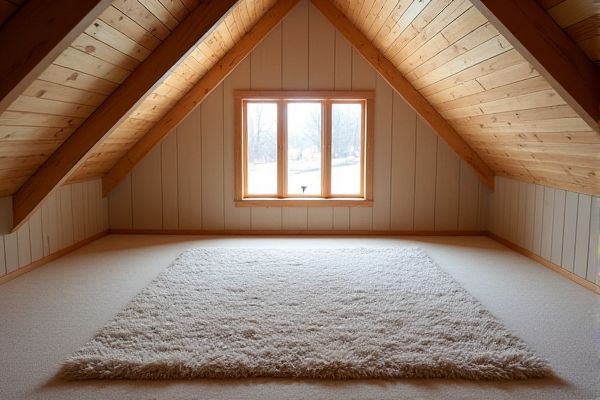
Attic rugs offer flexibility and easy maintenance, making them ideal for adding warmth and style without permanent installation, while wall-to-wall carpets provide seamless coverage, enhanced insulation, and noise reduction tailored to attic spaces. Discover which flooring option best suits your attic's needs and enhances your comfort by exploring the full comparison.
Table of Comparison
| Feature | Attic Rug | Wall-to-Wall Carpet (Attic) |
|---|---|---|
| Installation | Easy, portable, no adhesives | Permanent, requires professional installation |
| Coverage | Partial, customizable area | Full floor coverage |
| Cost | Lower initial cost | Higher upfront investment |
| Maintenance | Simple, can be cleaned separately | Requires regular vacuuming and occasional deep cleaning |
| Insulation | Moderate thermal and sound insulation | Better thermal and sound insulation due to full coverage |
| Replacement | Easy to replace or move | More complex and costly replacement |
| Design Flexibility | Wide variety of patterns and sizes | Design limited to installed carpet style |
| Durability | Less durable, prone to shifting | Durable, secured and long-lasting |
Introduction: Attic Rug vs Wall-to-Wall Carpet
An attic rug offers a flexible and cost-effective flooring solution, providing easy installation and the ability to change or clean it without disturbing the entire space. Wall-to-wall carpet in an attic delivers superior insulation and uniform coverage, enhancing energy efficiency and noise reduction. Choosing between the two depends on factors such as budget, aesthetic preferences, and the attic's intended use.
Material Choices for Attic Flooring
Attic rug options typically include natural fibers like wool and cotton, offering breathable and insulating properties ideal for attic environments with fluctuating temperatures. Wall-to-wall carpet for attics often favors synthetic materials such as nylon or polyester, providing durability and resistance to wear in high-traffic or storage areas. Selecting moisture-resistant backing and padding is essential to prevent mold and damage in both types of attic flooring.
Installation Process: Rugs vs Carpeting
Installing an attic rug involves simply laying it over the existing floor, making it a quick and flexible option that requires minimal preparation and can be easily replaced or moved. Wall-to-wall carpeting demands a more complex installation process including measuring, padding, stretching, and securing the carpet to tack strips along the attic perimeter, which ensures a seamless and permanent coverage. The choice between rugs and carpeting in attics depends on the desired durability, ease of maintenance, and installation commitment.
Insulation and Thermal Benefits
Attic rugs provide a flexible insulation layer that can be easily added or removed, helping to reduce heat loss by trapping air above the flooring. Wall-to-wall carpet in the attic offers continuous thermal protection, effectively minimizing drafts and improving energy efficiency throughout the entire space. Your choice between these options influences overall heat retention and comfort in the attic environment.
Design Flexibility and Aesthetic Options
Attic rugs offer greater design flexibility with their wide range of patterns, colors, and textures, allowing homeowners to easily change the look and feel of the space without a full renovation. Wall-to-wall carpet in an attic provides a seamless, uniform appearance that enhances insulation and comfort but limits customization to a single color or pattern for the entire area. Choosing between an attic rug and wall-to-wall carpet depends on the desired balance between aesthetic versatility and consistent coverage.
Maintenance and Cleaning Considerations
Attic rugs require regular vacuuming and spot cleaning to prevent dust buildup, while wall-to-wall carpet demands more frequent deep cleaning to maintain hygiene and appearance. Rugs can be easily removed for thorough cleaning or replacement, offering flexibility in attic maintenance. Your choice impacts cleaning frequency and effort, with rugs generally offering simpler upkeep compared to the extensive care needed for installed carpets.
Cost Comparison: Upfront and Long-Term
Attic rugs generally have a lower upfront cost compared to wall-to-wall carpets due to smaller material requirements and simpler installation. Wall-to-wall carpet, while more expensive initially, offers better insulation and durability, potentially reducing heating costs and the need for frequent replacements over time. Long-term expenses for wall-to-wall carpeting can be offset by its enhanced energy efficiency and lower maintenance compared to the periodic cleaning and occasional replacement of attic rugs.
Durability and Wear in Attic Spaces
Attic rugs typically offer higher durability in attic spaces due to their thicker fibers and ability to withstand uneven flooring compared to wall-to-wall carpet. Wall-to-wall carpeting may show accelerated wear and tear in attics because of frequent foot traffic and potential moisture exposure. Choosing high-density, stain-resistant materials enhances longevity and maintains aesthetic appeal in the unique conditions of attic environments.
Impact on Attic Functionality
Attic rugs provide a flexible flooring option that preserves easy access to insulation, wiring, and ventilation, maintaining the attic's primary functionality for storage or mechanical use. Wall-to-wall carpet in an attic can enhance comfort and sound insulation but may hinder access to critical systems and reduce ventilation, potentially affecting energy efficiency and structural integrity. Choosing an attic rug supports functionality without permanent alterations, whereas wall-to-wall carpeting offers a more finished look at the expense of attic accessibility.
Best Choice for Your Attic: Final Recommendations
Attic rugs offer flexibility, easy installation, and can be changed seasonally to suit your design preferences, making them ideal for smaller or less frequently used attic spaces. Wall-to-wall carpet provides superior insulation, soundproofing, and a seamless finish, perfect for attic conversions into living areas or bedrooms. Consider your attic's usage, budget, and insulation needs to determine the best flooring solution that enhances comfort and functionality.
 homyna.com
homyna.com